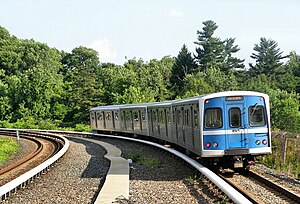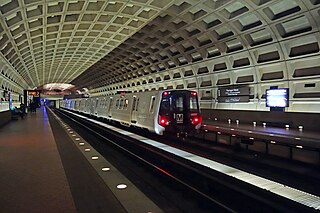
The Washington Metro, often abbreviated as the Metro and formally the Metrorail, is a rapid transit system serving the Washington metropolitan area of the United States. It is administered by the Washington Metropolitan Area Transit Authority (WMATA), which also operates the Metrobus service under the Metro name. Opened in 1976, the network now includes six lines, 98 stations, and 129 miles (208 km) of route.
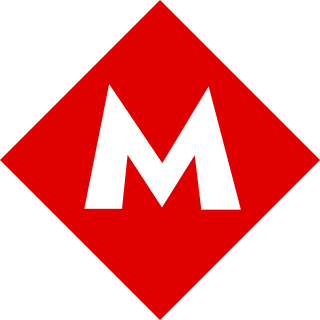
The Ankara Metro is the rapid transit system serving Ankara, the capital of Turkey. At present, Ankara's rapid transit system consists of two metro lines – the Batıkent Metrosu (M1) and the new Keçiören Metrosu (M4) line opened in 2017, along with the Ankaray line. The Ankaray, the M1 and M4 lines, together transported 104.1 million passengers in 2014. That corresponds to a ridership of approximately 289,155 per day. In February 2019 all the lines that used to run M1, M2 and M3 were merged to create one line, M1.

Miami-Dade Transit (MDT) is the primary public transit authority of Miami, Florida and the greater Miami-Dade County area. It is the largest transit system in Florida and the 15th-largest transit system in the United States. As of 2023, the system has 80,168,700 rides per year, or about 279,400 per weekday in the first quarter of 2024. MDT operates the Metrobus with their paratransit STS systems run by LSF. MDT also operates two rail transit systems: Metrorail and Metromover.
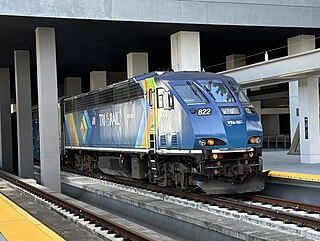
Tri-Rail is a commuter rail service linking Miami, Fort Lauderdale and West Palm Beach in Florida, United States. The Tri prefix in the name refers to the three counties served by the railroad: Palm Beach, Broward, and Miami-Dade. Tri-Rail is managed by the South Florida Regional Transportation Authority (SFRTA) along CSX Transportation's former Miami Subdivision; the line is now wholly owned by the Florida DOT. The 80.0-mile-long (128.7 km) system has 19 stations along the Southeast Florida coast, and connects directly to Amtrak at numerous stations, to Metrorail at the Metrorail Transfer station, Miami Airport station, and MiamiCentral, and to Brightline at MiamiCentral.

Metromover is a free to ride automated people mover system operated by Miami-Dade Transit in Miami, Florida, United States. Metromover serves the Downtown Miami, Brickell, Park West and Arts & Entertainment District neighborhoods. Metromover connects directly with Metrorail at Government Center and Brickell stations. It also connects to Metrobus with dedicated bus loops at Government Center and Adrienne Arsht Center station. It originally began service to the Downtown/Inner Loop on April 17, 1986, and was later expanded with the Omni and Brickell Loop extensions on May 26, 1994.

The Budd Company was a 20th-century metal fabricator, a major supplier of body components to the automobile industry, and a manufacturer of stainless steel passenger rail cars, airframes, missile and space vehicles, and various defense products.

Muni Metro is a semi-metro system serving San Francisco, California, United States. Operated by the San Francisco Municipal Railway (Muni), a part of the San Francisco Municipal Transportation Agency (SFMTA), Muni's light rail lines saw an average of 75,500 boardings per day as of the first quarter of 2024 and a total of 24,324,600 boardings in 2023, making it the sixth-busiest light rail system in the United States.
Hitachi Rail Italy S.p.A. is a multinational rolling stock manufacturer company based in Pistoia, Italy. Formerly AnsaldoBreda S.p.A., a subsidiary of state-owned Finmeccanica, the company was sold in 2015 to Hitachi Rail of Japan. After the deal was finalized, the current name was adapted in November 2015 to reflect the new ownership.
Bombardier Transportation was a Canadian-German rolling stock and rail transport manufacturer, with headquarters in Berlin, Germany. It was one of the world's largest companies in the rail vehicle and equipment manufacturing and servicing industry. Bombardier Transportation had many regional offices, production and development facilities worldwide. It produced a wide range of products including passenger rail vehicles, locomotives, bogies, propulsion and controls. In February 2020, the company had 36,000 employees, and 63 manufacturing and engineering locations around the world. Formerly a division of Bombardier Inc., the company was acquired by French manufacturer Alstom on 29 January 2021.

The Baltimore Metro SubwayLink is a rapid transit line serving Baltimore, Maryland, and its northwestern suburbs, operated by the Maryland Transit Administration. The segment in Downtown Baltimore is underground, while most of the line outside the central city is elevated or at surface grade. In 2023, the line had a ridership of 1,988,300, or about 14,400 per weekday as of the first quarter of 2024.
The rolling stock of the Washington Metro system consists of 1,242 75-foot (22.86 m) cars that were acquired across seven orders. All cars operate as married pairs, with systems shared across the pair. The 7000-series cars, the system's newest, have an operator's cab in only one of each married pair's cars and operate in groups of three or four.
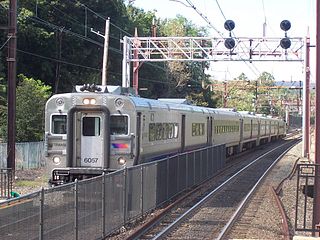
The Comet railcar is a class of locomotive-hauled railcars that was first designed in the late 1960s by Pullman-Standard as a modern commuter car for North American rail lines. Later, the Comet moniker was adopted by NJ Transit for all of its non-powered single level commuter coaches. Additional series of cars bearing the Comet name, based on the original design, have since been built by Bombardier Transportation and Alstom. The successful design was adopted by numerous commuter agencies.

Miami Intermodal Center (MIC) is an intermodal rapid transit, commuter rail, intercity rail, local bus, and intercity bus transportation hub in Miami-Dade County, Florida, just outside the Miami city limits near the Grapeland Heights neighborhood. The facility was constructed by the Florida Department of Transportation and is owned by the Greater Miami Expressway Agency.

The M1 and M3 are two similar series of electric multiple unit rail cars built by the Budd Company for the Long Island Rail Road, the Metro-North Railroad, and Metro-North's predecessors, Penn Central and Conrail. Originally branded by Budd as Metropolitans, the cars are more popularly known under their model names, M1 and M3. The Metro-North cars were branded under the M1A and M3A series.

Metrorail is a rapid transit system in Miami and Miami-Dade County in the U.S. state of Florida. Metrorail is operated by Miami-Dade Transit (MDT), a departmental agency of Miami-Dade County. Opened in 1984, it is Florida's only rapid transit metro system, and is currently composed of two lines of 23 stations on 24.4 miles (39.3 km) of standard gauge track. Metrorail serves the urban core of Miami, connecting Miami International Airport, the Health District, Downtown Miami, and Brickell with the northern developed neighborhoods of Hialeah and Medley to the northwest, and to suburban The Roads, Coconut Grove, Coral Gables, and South Miami, ending at urban Dadeland in Kendall. Metrorail connects to the Metromover in Downtown, which provides metro service to the entirety of Downtown and Brickell. Additionally, it connects to South Florida's commuter rail system at Tri-Rail station, as well as Metrobus routes at all stations. In 2023, the system had 13,439,300 rides, and about 51,500 per day in the first quarter of 2024.

The A650 is an electric multiple unit rapid transit car built for use on the Los Angeles Metro Rail system. The cars were manufactured by the Italian company Breda at its Pistoia plant in Italy between 1988 and 1997 and are used on the Metro B and D Lines.
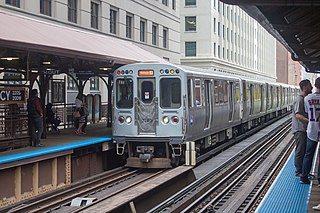
The 2600-series is a series of Chicago "L" car built between 1981 and 1987 by the Budd Company of Philadelphia, Pennsylvania. 600 cars were built, and 491 of them remain in service.

The Miami metropolitan area composed of the three counties of Miami-Dade, Broward, and Palm Beach, also known collectively as South Florida, is home to a wide variety of public and private transportation systems.

The Underline is a 10-mile linear park being developed in Miami-Dade County, Florida. When complete, it will run underneath the county's elevated Metrorail system from the Miami River near Brickell to the Metrorail's southern terminus at Dadeland South. The project is essentially upgrading a pre-existing bike path, known as the M-Path, into a full linear park. As of 2024, the first phase of The Underline was completed in the Brickell area on February 26, 2021. The second phase, which runs from Brickell to just south of Vizcaya station, was completed on April 24, 2024. The third and final phase will be completed in 2026.

The HR5000 is an electric multiple unit rapid transit car ordered from Hyundai Rotem for the Los Angeles Metro Rail's B and D lines.
